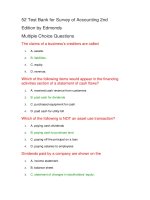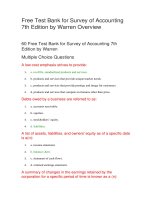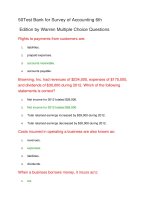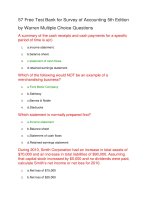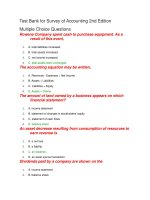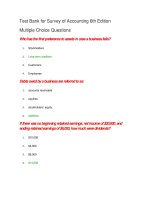Survey of accounting 6e chapter 9
Bạn đang xem bản rút gọn của tài liệu. Xem và tải ngay bản đầy đủ của tài liệu tại đây (2.2 MB, 41 trang )
Financial Statement Analysis
Chapter
9
©2013 Cengage Learning. All Rights Reserved. May not be scanned, copied or duplicated, or posted to a publically accessible website, in whole or in part.
Learning Objectives
After studying this chapter, you should be able to:
•Describe basic financial statement analytical
methods.
•Use financial statement analysis to assess the
liquidity and solvency of a business.
•Use financial statement analysis to assess the
profitability of a business.
•Describe the contents of corporate annual reports.
©2013 Cengage Learning. All Rights Reserved. May not be scanned, copied or duplicated, or posted to a publically accessible website, in whole or in part.
Learning
Objective 1
Describe basic financial statement
analytical procedures
©2013 Cengage Learning. All Rights Reserved. May not be scanned, copied or duplicated, or posted to a publically accessible website, in whole or in part.
Horizontal Analysis
• The __________ analysis of _________ and
_________ in related items in _________
financial statements
Exhibit 1: Comparative Balance Sheet— Horizontal Analysis
©2013 Cengage Learning. All Rights Reserved. May not be scanned, copied or duplicated, or posted to a publically accessible website, in whole or in part.
Vertical Analysis
• A __________ analysis used to show the
relationship of each __________ to the
________ within __________ statement
Exhibit 5: Comparative Balance Sheet— Vertical Analysis
©2013 Cengage Learning. All Rights Reserved. May not be scanned, copied or duplicated, or posted to a publically accessible website, in whole or in part.
Benefits of Analysis
• ________ and ________analysis are useful
in assessing relationships and trends in
financial conditions and operations of a
business
• ________analysis is useful for comparing
one company with another or with industry
averages
• ________ is made easier with commonsized financial statements
©2013 Cengage Learning. All Rights Reserved. May not be scanned, copied or duplicated, or posted to a publically accessible website, in whole or in part.
Common-Sized Statements
Exhibit 7: Common- Sized Income Statement
©2013 Cengage Learning. All Rights Reserved. May not be scanned, copied or duplicated, or posted to a publically accessible website, in whole or in part.
Learning
Objective 2
Use financial statement analysis to
assess the liquidity and solvency of
a business
©2013 Cengage Learning. All Rights Reserved. May not be scanned, copied or duplicated, or posted to a publically accessible website, in whole or in part.
Liquidity and Solvency
• _________ – the ability of a business to
pay its debts
• _________ – the ability of a business to
convert assets into cash.
_________, _______, and __________
are interrelated!
©2013 Cengage Learning. All Rights Reserved. May not be scanned, copied or duplicated, or posted to a publically accessible website, in whole or in part.
Solvency Analysis
• Normally assessed by examining _________
relationships, using the following major
analyses:
•
•
•
•
•
•
Current position analysis
Accounts receivable analysis
Inventory analysis
Ratio of fixed assets to long-term liabilities
Ratio of liabilities to stockholders’ equity
Number of times interest charges are earned
©2013 Cengage Learning. All Rights Reserved. May not be scanned, copied or duplicated, or posted to a publically accessible website, in whole or in part.
Current Position Analysis
• Using measures to assess a business’s
ability to ______________
• __________– current assets less current
liabilities
• ________ – current assets divided by current
liabilities
• _________ – total “quick” assets divided by
current liabilities
©2013 Cengage Learning. All Rights Reserved. May not be scanned, copied or duplicated, or posted to a publically accessible website, in whole or in part.
Current Position Analysis – Working Capital
and Current Ratio
Mooney Company
©2013 Cengage Learning. All Rights Reserved. May not be scanned, copied or duplicated, or posted to a publically accessible website, in whole or in part.
Current Position Analysis – Quick Ratio
Quick Ratio
Quick Assets
Current Liabilities
=
Quick Assets
$280,500
Quick Assets
$160,000
Quick Ratio:
Mooney
$__________÷ $______= ______
Wendt
$__________÷ $______= ______
©2013 Cengage Learning. All Rights Reserved. May not be scanned, copied or duplicated, or posted to a publically accessible website, in whole or in part.
Accounts Receivable Analysis
• Measures efficiency of collection
• Reflects liquidity
Accounts Receivable Turnover =
Number of Days’ Sales in
Receivables
=
©2013 Cengage Learning. All Rights Reserved. May not be scanned, copied or duplicated, or posted to a publically accessible website, in whole or in part.
Accounts Receivable Turnover
The company _______ its accounts receivable turnover by _____
measured in terms of the number of times receivables are collected
within the year.
©2013 Cengage Learning. All Rights Reserved. May not be scanned, copied or duplicated, or posted to a publically accessible website, in whole or in part.
Days’ Sales in Receivables
The company improved its collections of
accounts receivable by 10.9 days in 2012
measured in days receivables have been
outstanding.
©2013 Cengage Learning. All Rights Reserved. May not be scanned, copied or duplicated, or posted to a publically accessible website, in whole or in part.
Inventory Analysis
• Measures inventory ________
• Avoid tying up funds in _________
• Avoid _________
• Reflects liquidity
Inventory Turnover
=
Number of Days’ Sales =
in Inventory
©2013 Cengage Learning. All Rights Reserved. May not be scanned, copied or duplicated, or posted to a publically accessible website, in whole or in part.
Inventory Turnover
The company turned its inventory 1 time more in
2012, measured in terms of the number of times
inventory turns over within the year.
©2013 Cengage Learning. All Rights Reserved. May not be scanned, copied or duplicated, or posted to a publically accessible website, in whole or in part.
Days’ Sales in Inventory
The company reduced the time it held inventory by
nearly 28% in 2012 measured in days the inventory
was held in warehouses.
©2013 Cengage Learning. All Rights Reserved. May not be scanned, copied or duplicated, or posted to a publically accessible website, in whole or in part.
Ratio of Fixed Assets to LongTerm Liabilities
• Indicates the ___________ for note-holders
or bondholders
• Indicates the ability to ___________ on a
long-term basis
Fixed Assets to Long-Term
=
Liabilities
Fixed Assets (net)
Long-Term Liabilities
©2013 Cengage Learning. All Rights Reserved. May not be scanned, copied or duplicated, or posted to a publically accessible website, in whole or in part.
Ratio of Fixed Assets to LongTerm Liabilities
The company increased its margin of safety in
financing fixed assets mainly by lowering longterm debt.
©2013 Cengage Learning. All Rights Reserved. May not be scanned, copied or duplicated, or posted to a publically accessible website, in whole or in part.
Ratio of Liabilities to Stockholders’
Equity
• Indicates the margin of ___________.
• Indicates the ability to __________________.
Liabilities to Stockholders’
=
Equity
Total Liabilities
Total Stockholders’ Equity
©2013 Cengage Learning. All Rights Reserved. May not be scanned, copied or duplicated, or posted to a publically accessible website, in whole or in part.
Ratio of Liabilities to Stockholders’
Equity
The ratio shows an increasing margin of
safety for creditors.
©2013 Cengage Learning. All Rights Reserved. May not be scanned, copied or duplicated, or posted to a publically accessible website, in whole or in part.
Number of Times Interest
Charges Earned
• Indicates the general ___________________
of the business
• Indicates the ability to __________ adverse
business conditions
Times Interest Charges
Earned
=
Income before Taxes + Interest Expense
Interest Expense
©2013 Cengage Learning. All Rights Reserved. May not be scanned, copied or duplicated, or posted to a publically accessible website, in whole or in part.
Number of Times Interest
Charges Earned
The number of times interest charges are
earned improved from 12.2 to 28.1, a significant
measure of safety for creditors.
©2013 Cengage Learning. All Rights Reserved. May not be scanned, copied or duplicated, or posted to a publically accessible website, in whole or in part.

